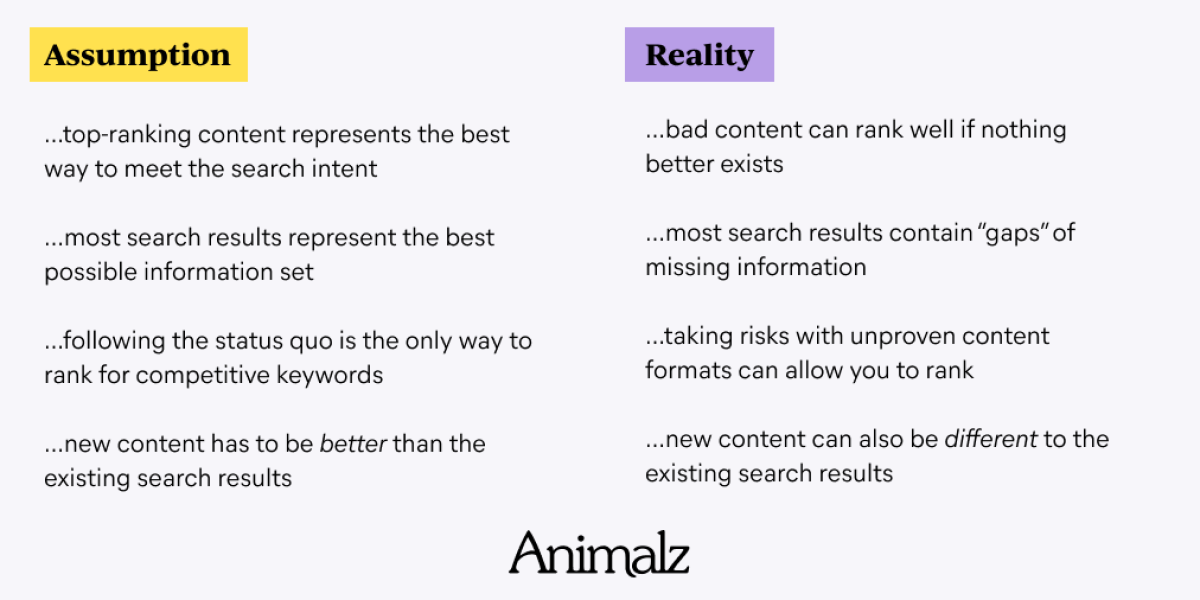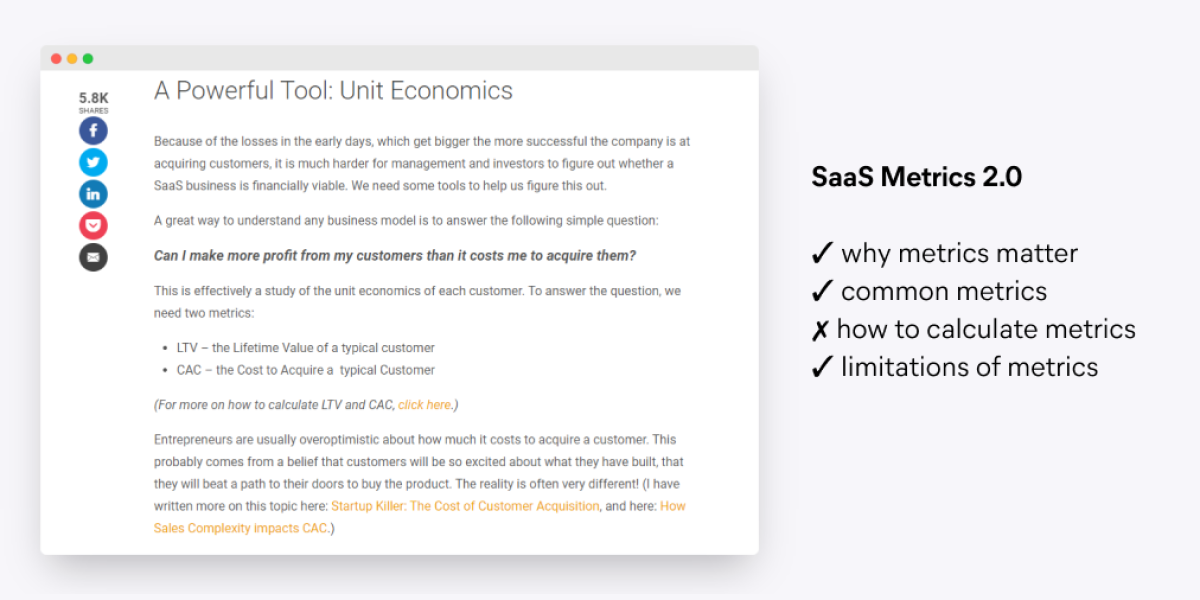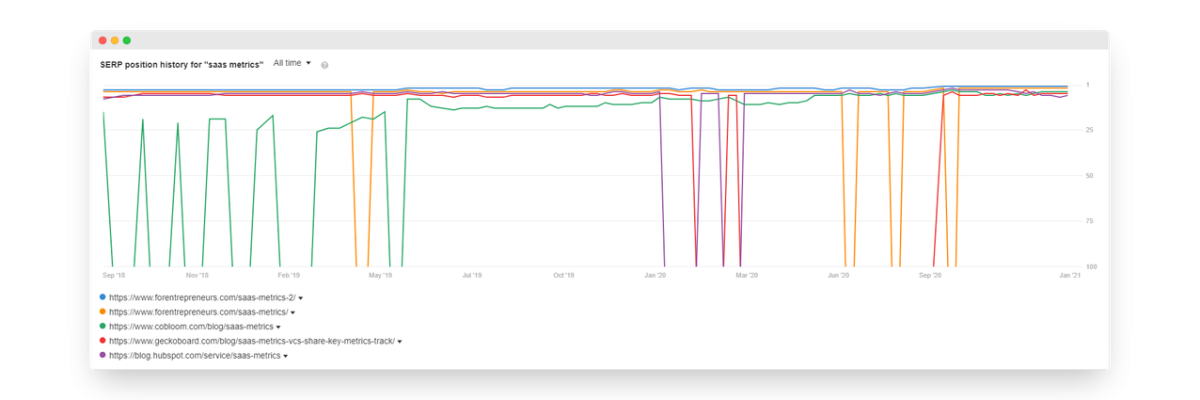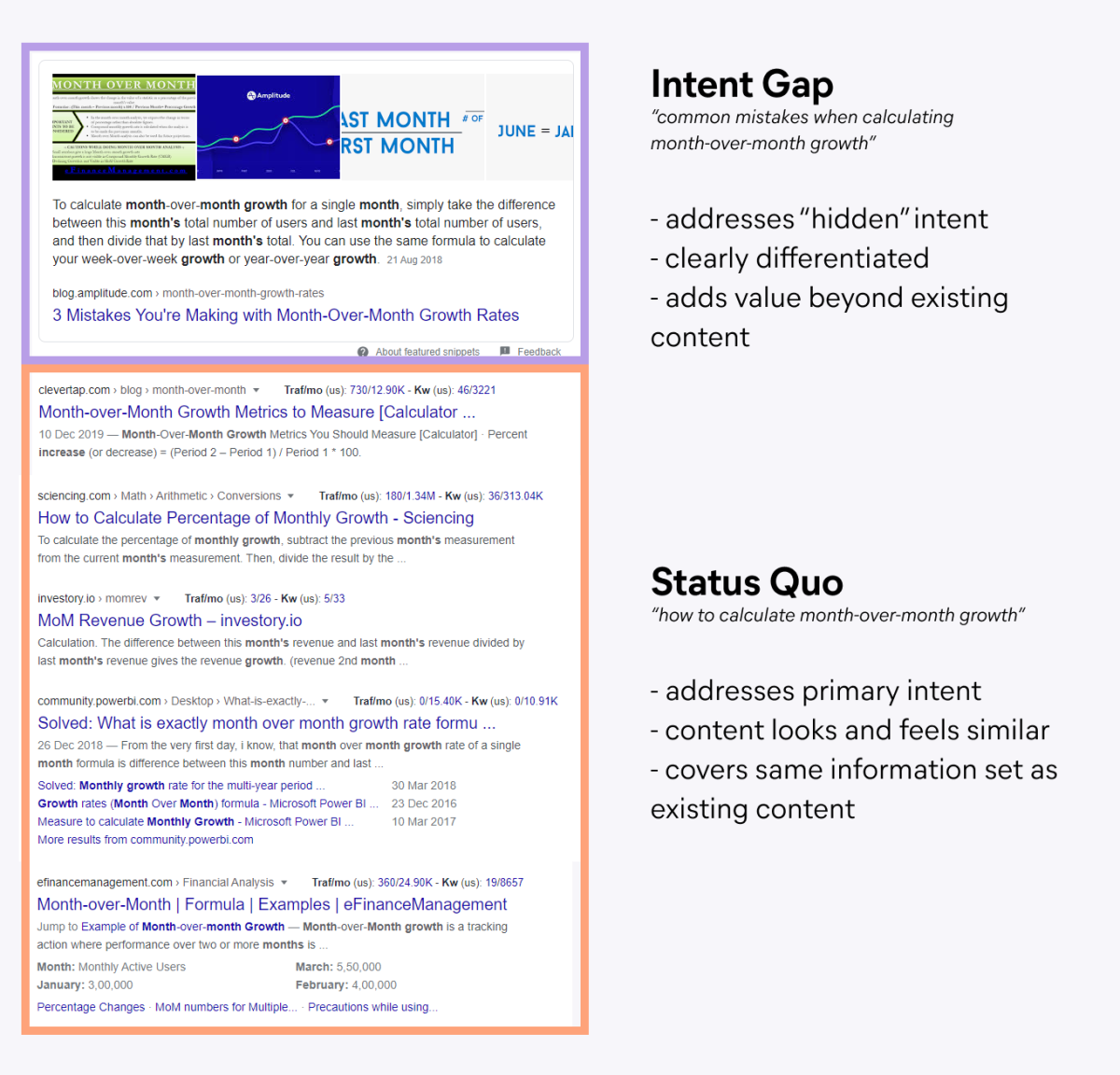The way most companies approach content marketing is predicated on the unspoken idea that Google knows best.For any keyword, they search through results page after results page to work out what Google “wants” them to write. They create content that aggregates tactics and ideas from the top-ranking content. Most of all, they avoid anything risky—new formats or angles—because they’re afraid to deviate from the status quo.In fact, when faced with page after page of carefully ordered search results, virtual carbon copies of one another, it’s natural to think that Google’s vast databases and powerful machine learning algorithms have “solved” the search results. A winning strategy has been discovered, Google has surfaced the perfect information to satisfy the query, and a clear type of content dominates the results. There is nothing more to say. You are too late to the party.But you would be wrong.
Finding Google’s “Intent Gaps”
There are two problems with this thinking:
Bad articles benefit from good rankings because nothing better exists. There’s a computer science term—garbage in, garbage out—that says that the output of a given model is only as good as the data you put in to it. The same principle applies here. Google doesn’t have access to an infinite pool of articles. For any given query, it’s limited by what’s already out there. In most cases, that means that Google is picking the best articles from a bad bunch. For virtually every keyword, there are opportunities to create something radically better.
Most keywords harbor dozens of different search intents. When keywords have a simple and obvious intent behind them, Google is likely serving pretty-much-perfect content (there’s not much more to be said on the topic of “how to type the shrug emoji”). But most keywords harbor so many variations, meanings, interpretations, intents and use cases that every SERP represents only a small portion of the total information landscape. Even if one “angle” has been written to death, there are almost always opportunities to tackle the same topic in a different way.
This is where our human brain has an edge over the algorithm.

Instead of looking at a competitive SERP and assuming that Google knows best, we can critically evaluate the results. Instead of copycatting the existing search results, or worse, abandoning a too-competitive keyword entirely, we can dig deeper and find the intent “gaps”—crucial questions, ideas or data points that are entirely absent from any of the search results.These can take many forms:
Unserved intent (“My specific use case isn’t represented here.”)
Missing information (“It’s weird that no one has mentioned X here.”)
Differing and erroneous opinions (“That’s an outdated belief.”)
Mistakes in Google’s comprehension (“That’s not what I meant by this keyword.”)
Deviating from the status quo to address these “gaps” is a potent tool for carving out your own spot in competitive search results. While other companies brawl over a single search intent, you can claim ownership over a niche part of the audience with your own radically different angle.

Here’s an example.
Using Intent Gaps to Rank for Competitive Keywords
The keyword “saas metrics” has long been contested by content from authoritative, well-known brands: Geckoboard, ProfitWell, Openview Venture Partners and—arguably, one of the most important startup articles ever written—David Skok’s SaaS Metrics 2.0. Each article is a long, articulate treatise on the importance of churn and lifetime value. In other words, the “saas metrics” keyword well seems thoroughly tapped.But take the time to read each article, and one obvious intent gap becomes clear. Despite tens of thousands of cumulative words, each article glosses over the mathematical formulae for each metric. Finish reading these top-ranking articles, and you’d still struggle to actually calculate any of the metrics covered.

Such an obvious omission seems almost deliberate. Google, in all its omniscience, must be choosing to omit articles that focus on the mathematics of SaaS metrics because they don’t meet the search intent.
This same thought process flickers through the mind of every SEO and content marketer on a daily basis. We assume that Google knows best—that it’s signaling to us the type of content required to meet the search intent—and we use the existing search results to guide our hand and shape the content we create.But in the case of “saas metrics,” this omission was oversight, not omniscience. Here’s how I know: I published a dry, mathematical article focused myopically on the formulae and definitions of 50 common SaaS metrics—no broader context and very little crossover with the existing search results.
And despite fewer links, lower domain authority, no brand awareness and an article that looked nothing like the existing results, the article wrested its way into a top three spot (the green line, below).

“SaaS metrics” is a relatively broad short-tail keyword, but even a query as straightforward as “how to calculate month over month growth” can harbor hidden search intent.
While most of the search results slug it out with simple definitions, Amplitude has claimed the #1 spot by focusing on one nuance of month-on-month growth that no other article had touched upon: the mistakes commonly made in its calculation.

Don’t Mistake Oversight for Omniscience
It often pays to heed Google’s guidance using the existing search results to understand the intent driving each search—but it’s a mistake to assume that Google is perfect.Google’s search algorithms are stunningly powerful, but they are not omniscient. Mistakes happen, opportunities go missed, and bad articles benefit from top rankings because nothing better exists. When we ignore these oversights, we limit ourselves to the same tired content types that show up ad nauseam in the search results without listening to the part of our brain that whispers, “There should be something better here.”As content marketers, we can use this fallibility to our advantage. We can carve out lucrative niches within even the most competitive search results. We can stand out with angles and ideas that are more interesting than anything that’s come before. We can take a risk and be rewarded for doing so.
